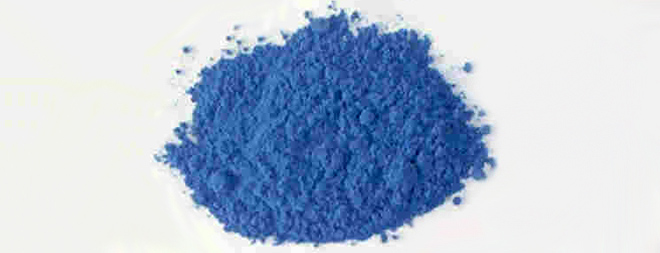Ancient Egyptian Pigment's Future Now Even Brighter

Considered to be the first synthetic pigment, Egyptian blue (also known as calcium copper silicate) was used by many cultures for thousands of years.
Image credits: FK1954 via Wikimedia Commons
(Inside Science) -- An ancient Egyptian pigment -- apparently humanity's first artificial pigment -- could soon find new life-enabling modern high-tech applications such as telecommunications networks and state-of-the-art biomedical imaging, according to researchers.
Known as Egyptian blue, the pigment first appeared roughly 5,000 years ago in a tomb painting dated to the reign of Ka-sen, the last king of Egypt's First Dynasty.
"Egyptian blue was the first synthetic pigment produced by people, so it represents a major milestone for both human civilization and the development of chemistry," said researcher Tina Salguero, a chemist and materials scientist at the University of Georgia, in Athens, Ga.
The strikingly bright blue pigment embellished paintings on statues and other artifacts throughout the ancient Mediterranean world. Examples of it have been found on the belt of the statue of Iris, messenger goddess of the rainbow, in the Parthenon in Athens, and in a fresco of a garden in the afterlife found in the tomb of the Egyptian scribe and counter of grain Nebamun in Thebes, Egypt.
The material giving Egyptian blue its color is calcium copper silicate. It was made by grinding sand, lime and copper (or copper ore) and heating the mixture in a furnace.
"Its manufacture was shared by the Egyptians with occupying and neighboring groups -- Greeks, then Romans -- spreading the technology throughout the Mediterranean," said art and artifacts conservator Renee Stein at Emory University in Atlanta.
After the era of ancient Rome, its method of creation was completely lost and remained a mystery for more than 1,500 years. However, in the 19th century, excavations at the ruins of Pompeii -- the Roman city famously buried under volcanic ash when Mount Vesuvius erupted nearly 2,000 years ago -- uncovered many spectacular wall paintings made with Egyptian blue, prompting scientific efforts that ultimately revealed the pigment's composition.
When irradiated with visible light, Egyptian blue emits near-infrared rays with exceptional strength, with even single particles of the pigment detectable from a distance of a few yards. This suggests Egyptian blue could have a variety of modern applications. For instance, this radiation is similar to the beams that communicate between remote controls and TVs, car door locks, and other telecommunications devices. It could also find use in advanced biomedical imaging "because near-infrared radiation penetrates through tissue better than other wavelengths," Salguero said.
Given how many specimens of Egyptian blue have survived for millennia, scientists had thought it a relatively durable pigment. Unexpectedly, Salguero and her colleagues now find it can peel off in microscopic sheets under remarkably simple conditions — stirring in hot water. It can break apart into narrow sheets just a bit larger than 1 billionth of a meter thick, so thin that more than 80,000 individual sheets could fit across the width of the average human hair.
"This aspect of Egyptian blue's chemistry was under our noses for millennia," Salguero said. "The discovery wasn't made earlier for two main reasons — nobody was looking, and now we actually have the tools to image things with nanometer dimensions."
The discovery that Egyptian blue is relatively simple to use in solutions as inks "opens up entirely new ways to incorporate this material into modern applications," Salguero said. In experiments, researchers found they could use an inkjet printer to express an Egyptian blue nano-sheet.
"Inkjet printing is a way to fabricate structures or devices that can incorporate the near-infrared-emitting properties of the material," Salguero said. The researchers detailed their findings in the Feb. 6 issue of the Journal of the American Chemical Society.
Although other near-infrared-emitting materials exist, "Egyptian blue is composed of abundant and inexpensive elements — calcium, copper, silicon, and oxygen — in contrast to other near-infrared-emitting materials that contain rare earth elements. This feature could provide economic and environmental benefits to future applications," Salguero said
The scientists are now investigating similar materials, but it remains uncertain how Egyptian blue might be relatively durable given how easily it comes apart in hot water.
"It is important for us to understand how materials change over time and how they can be affected by their environments," Stein said.

